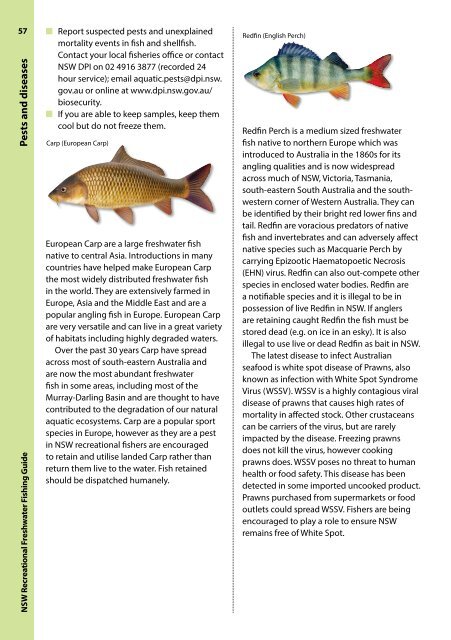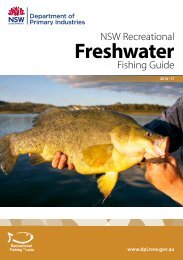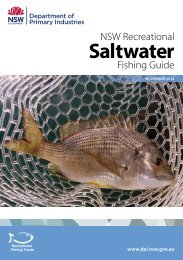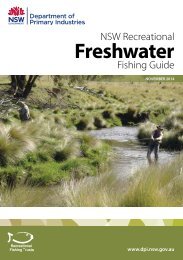freshwater-recreational-fishing-guide-2018-19
You also want an ePaper? Increase the reach of your titles
YUMPU automatically turns print PDFs into web optimized ePapers that Google loves.
57 ■■<br />
Report suspected pests and unexplained<br />
mortality events in fish and shellfish.<br />
Contact your local fisheries office or contact<br />
NSW DPI on 02 4916 3877 (recorded 24<br />
hour service); email aquatic.pests@dpi.nsw.<br />
gov.au or online at www.dpi.nsw.gov.au/<br />
biosecurity.<br />
■■<br />
If you are able to keep samples, keep them<br />
cool but do not freeze them.<br />
NSW Recreational Freshwater Fishing Guide Pests and diseases<br />
Carp (European Carp)<br />
European Carp are a large <strong>freshwater</strong> fish<br />
native to central Asia. Introductions in many<br />
countries have helped make European Carp<br />
the most widely distributed <strong>freshwater</strong> fish<br />
in the world. They are extensively farmed in<br />
Europe, Asia and the Middle East and are a<br />
popular angling fish in Europe. European Carp<br />
are very versatile and can live in a great variety<br />
of habitats including highly degraded waters.<br />
Over the past 30 years Carp have spread<br />
across most of south-eastern Australia and<br />
are now the most abundant <strong>freshwater</strong><br />
fish in some areas, including most of the<br />
Murray-Darling Basin and are thought to have<br />
contributed to the degradation of our natural<br />
aquatic ecosystems. Carp are a popular sport<br />
species in Europe, however as they are a pest<br />
in NSW <strong>recreational</strong> fishers are encouraged<br />
to retain and utilise landed Carp rather than<br />
return them live to the water. Fish retained<br />
should be dispatched humanely.<br />
Redfin (English Perch)<br />
Redfin Perch is a medium sized <strong>freshwater</strong><br />
fish native to northern Europe which was<br />
introduced to Australia in the 1860s for its<br />
angling qualities and is now widespread<br />
across much of NSW, Victoria, Tasmania,<br />
south-eastern South Australia and the southwestern<br />
corner of Western Australia. They can<br />
be identified by their bright red lower fins and<br />
tail. Redfin are voracious predators of native<br />
fish and invertebrates and can adversely affect<br />
native species such as Macquarie Perch by<br />
carrying Epizootic Haematopoetic Necrosis<br />
(EHN) virus. Redfin can also out-compete other<br />
species in enclosed water bodies. Redfin are<br />
a notifiable species and it is illegal to be in<br />
possession of live Redfin in NSW. If anglers<br />
are retaining caught Redfin the fish must be<br />
stored dead (e.g. on ice in an esky). It is also<br />
illegal to use live or dead Redfin as bait in NSW.<br />
The latest disease to infect Australian<br />
seafood is white spot disease of Prawns, also<br />
known as infection with White Spot Syndrome<br />
Virus (WSSV). WSSV is a highly contagious viral<br />
disease of prawns that causes high rates of<br />
mortality in affected stock. Other crustaceans<br />
can be carriers of the virus, but are rarely<br />
impacted by the disease. Freezing prawns<br />
does not kill the virus, however cooking<br />
prawns does. WSSV poses no threat to human<br />
health or food safety. This disease has been<br />
detected in some imported uncooked product.<br />
Prawns purchased from supermarkets or food<br />
outlets could spread WSSV. Fishers are being<br />
encouraged to play a role to ensure NSW<br />
remains free of White Spot.








